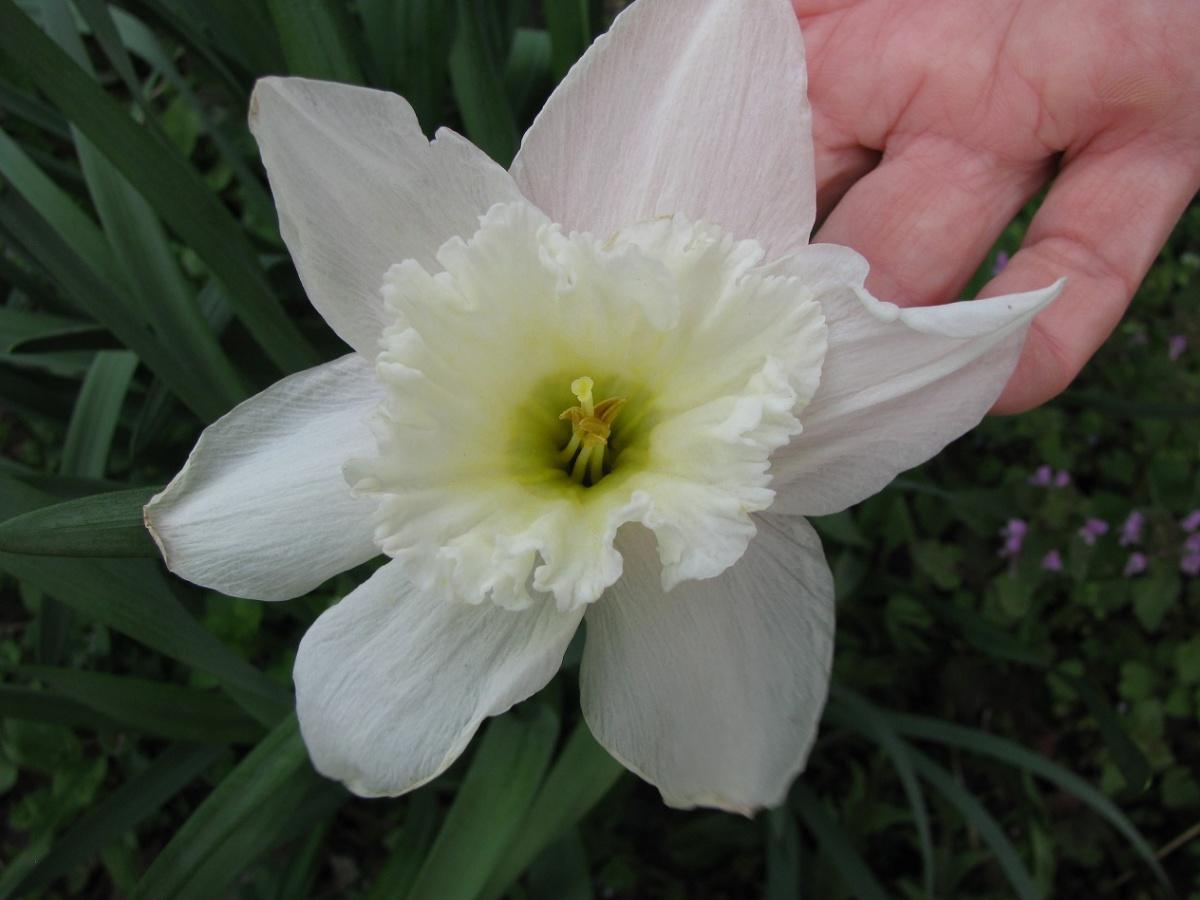
- Features of Daffodils;
- Sizes and Blooms;
- Pruning of Flowers and Leaves;
- Rejuvenation and Transplantation;
- Top Dressing;
- Growing at Home;
- Pest and Disease Control;
- Variety of Shades;
- White Daffodils;
- Yellow Daffodil;
- Pink Daffodils;
- Types of Daffodils;
- Tubular Daffodils;
- Large Cupped Daffodils;
- Small Cupped Daffodils;
- Terry Daffodils;
- N. Triandrus L Daffodils;
- Cyclamineus Daffodils;
- N. Jonquilla L. Daffodils;
- Tazetta Daffodils;
- Poeticus Daffodils;
- Split-corona: Collar and Split-corona: Papillon;
- Hybrid (N. Bulbocodium);
- Best Flower Varieties with Names;
- Tips for Choosing;
Daffodils are grateful and unpretentious plants. The main care for them falls in the spring and is reduced to fertilizing and watering as necessary. The most time-consuming in the care of these bulbs is considered to be transplanting: it is not as difficult as in the case of tulips, but still to preserve the decorativeness, they require not such a rare division and transplantation. In favorable years, when the weather is favorable, the plants almost do not need care and excessive attention. Daffodils are crops that fit perfectly into the concept of a “lazy” garden, allowing you to significantly simplify the load associated with garden chores, but at the same time, even with minimal attention, they delight with a lush spring parade of fragrant flowers.
Features of Daffodils

These are some of those plants that are able to be content with little care. In normal weather, they will not need regular watering even during flowering. Moreover, waterlogging of the soil is very dangerous for the plant. But if the weather does not spoil or there is a very long drought, then maintenance watering is introduced for them during the periods of budding and flowering. One deep-soaking soil irrigation per week is enough.
Watering is carried out carefully, not allowing the flowers and buds to get wet. The use of a sprinkler is undesirable.
Sizes and Blooms
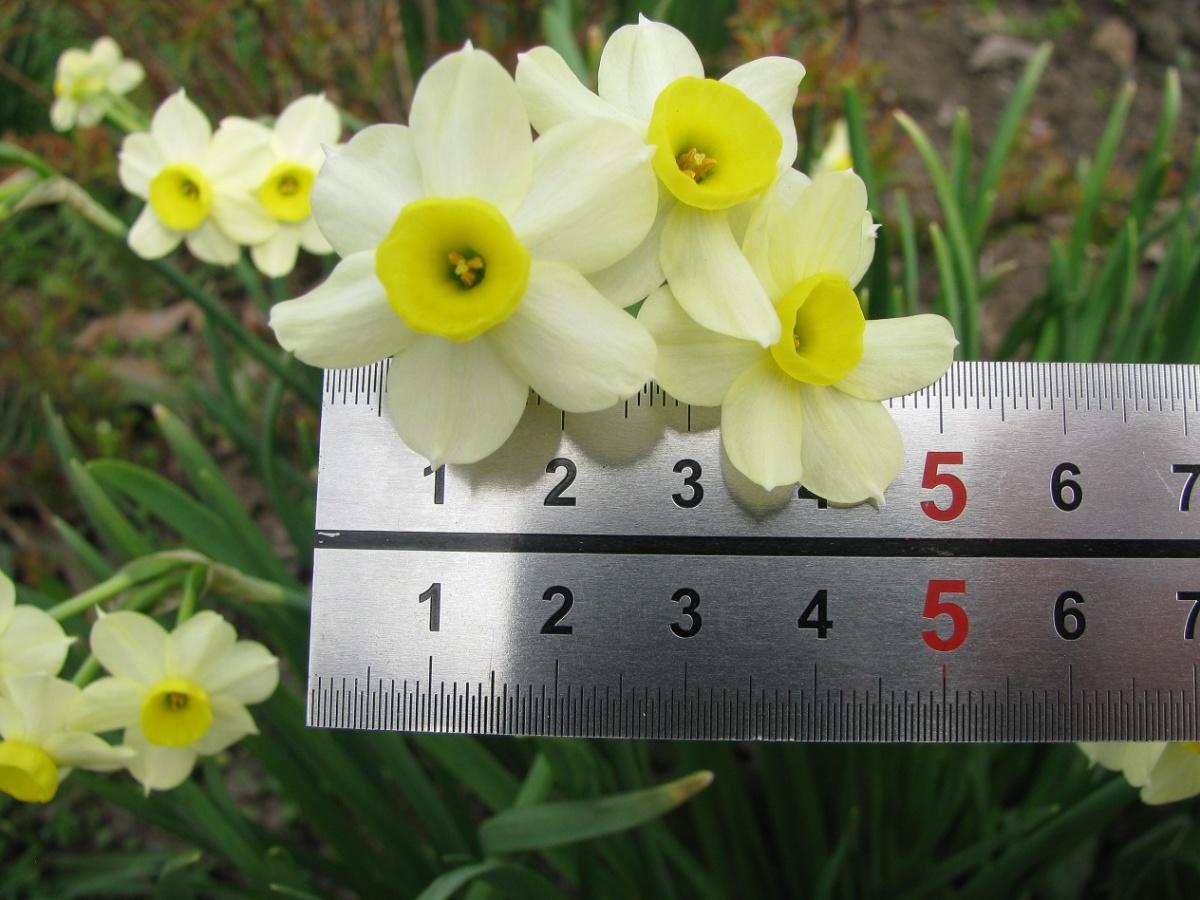
The flower is huge! When it first bloomed, it was 11 cm (4.3 inch), and by the end of flowering (already the tips of the petals are drying out), it grew to 15 cm (5.9 inch)! The height is about 30 cm (11.8 inch), the stems are strong, do not fall under the weight of the flower.
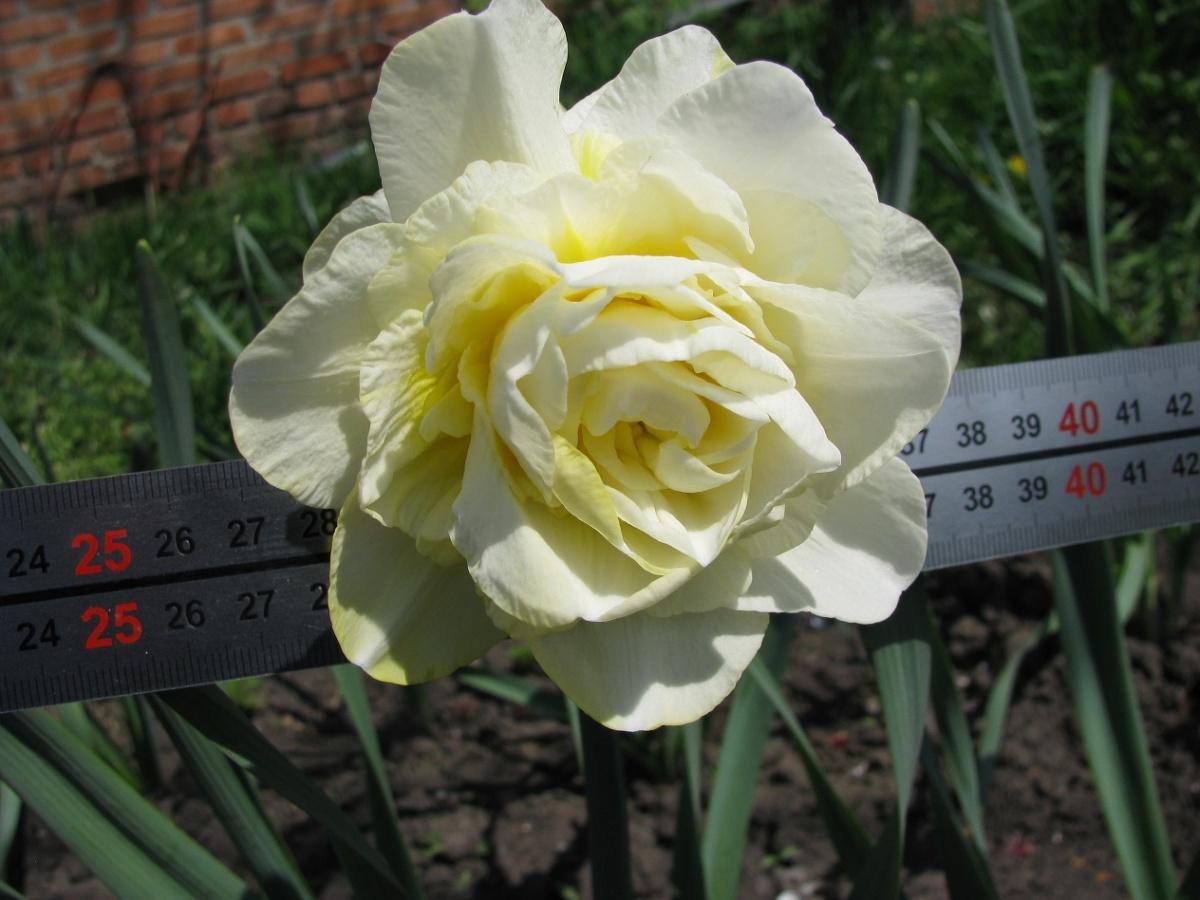
In the case of a variety containing a flower up to 12 cm (4.7 inches) in diameter, you will have to stock up on flower stands, because to make the bush look good, this beauty requires a separate support for each flower.
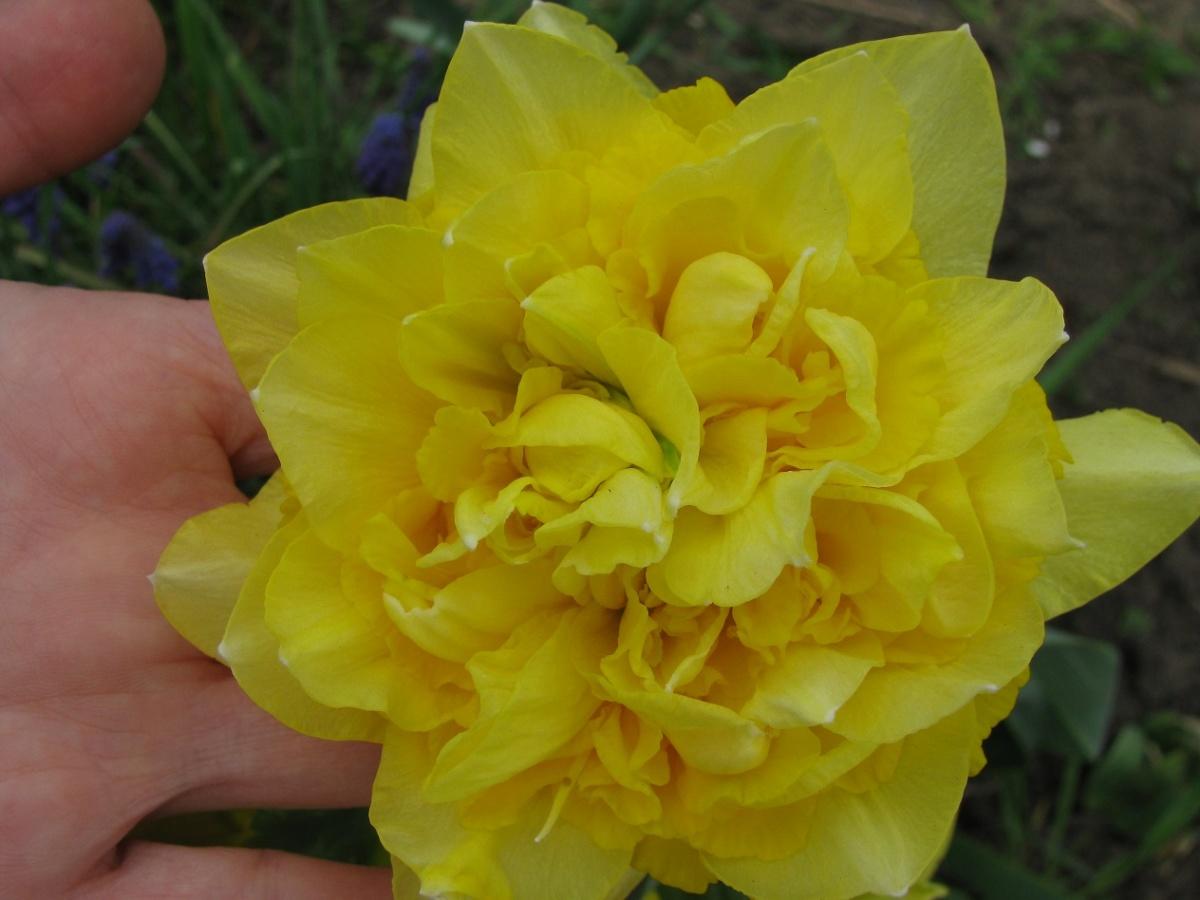
And this is the opposite, with tiny buds. Low bush 20-25 cm (7.9-9.8 inches), no higher. It grows very fast and forms a picturesque group.
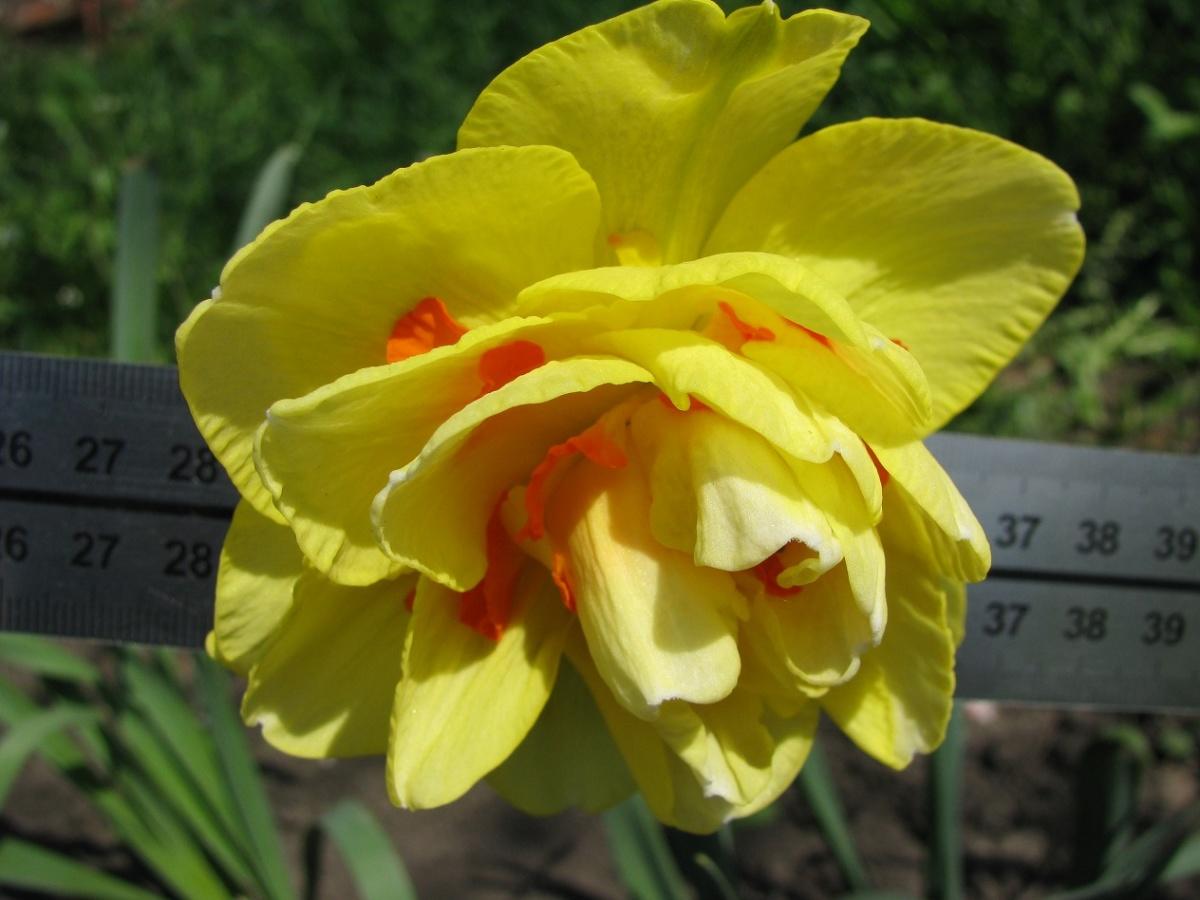






Pruning of Flowers and Leaves

In daffodils, it is advisable to remove the faded flowers immediately, without delay, along with the peduncle. The formation of seeds in this bulbous plant should not be allowed (unless you leave several plants for the purpose of collecting seeds).
The leaves are not removed until they not only turn yellow, but also completely dry. Despite the significant damage to the decorative nature of the flower garden, the leaves of this plant should die off independently and naturally. The process of drying of the leaves lasts almost a month and a half, and during this period it is better not to touch the plants.
At the slightest signs of damage to plants by diseases or pests, it is better to immediately remove and destroy them, even if they begin the flowering process.
Rejuvenation and Transplantation
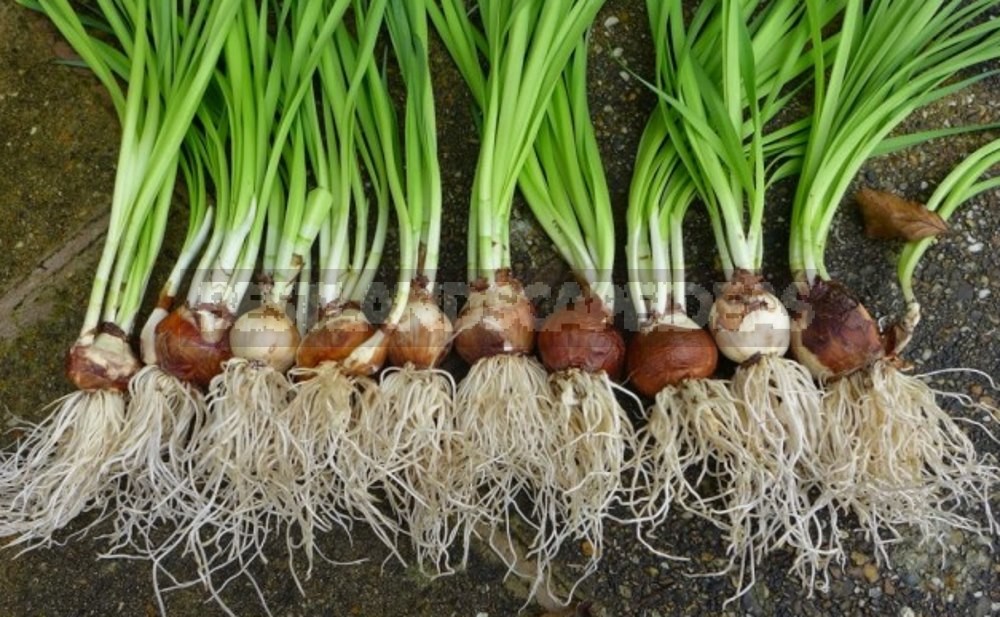
Daffodils mostly belong to the bulbous ones, which do not require annual digging. In one place, they can safely remain up to a dozen years, but in order to maintain high decorative and varietal characteristics, it is better to plan a mandatory separation and transplantation with a frequency of 1 every 4-5 years. At the same time, it is always necessary to focus on a decrease in the number of flowers, a qualitative deterioration in flowering, and not on any other signs. And if the daffodils bloom sparsely compared to the previous year, then you should not delay with the transplant. There are exceptions to the rule: new varieties are often recommended to be dug out annually (it is always better to focus on individual requirements and specify information about this when buying).
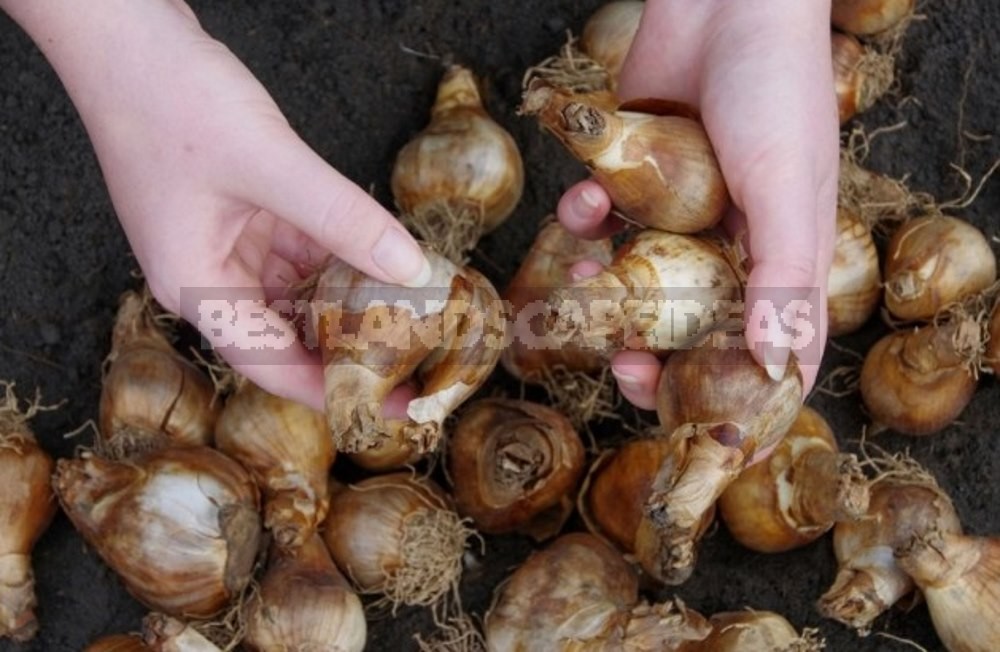
The plants are dug up after they have completely yellowed and drooped foliage. A late excavation is much more dangerous than a slightly earlier one, since the beginning of re-rooting of the bulbs then significantly affects the quality of the planting material. Daffodils bloom early, but do not leave the garden scene so quickly, and usually digging is carried out only in late June-July.
The digging process itself is quite simple:
- Bulbs are dug out with a large reserve of soil, as carefully as possible, manually freeing them from the substrate.
- All bulbs are examined, immediately selecting and destroying specimens with the slightest signs of pest damage.
- The bulbs are cleaned and sorted by size and variety.
- Disinfection is carried out in a solution of fungicide or potassium permanganate.
- In the open air, in ventilated shallow containers and in the shade, the bulbs are dried for 2 to 3 days.
- Next, the bulbs are removed to ventilated dry rooms for summer storage (at the same time, restrained temperatures of about 18°C (64.4°F) are desirable).
Planting is carried out in August or the first decade of September on pre-prepared areas, according to the general rules of planting (in groups, to a depth of 10 to 20 cm (4-8 inch), depending on the size of the bulbs). After planting, the plants need watering in drought, mulching and shelter for the winter with dry leaves (the shelter is removed as soon as possible after the snow melts).
Top Dressing
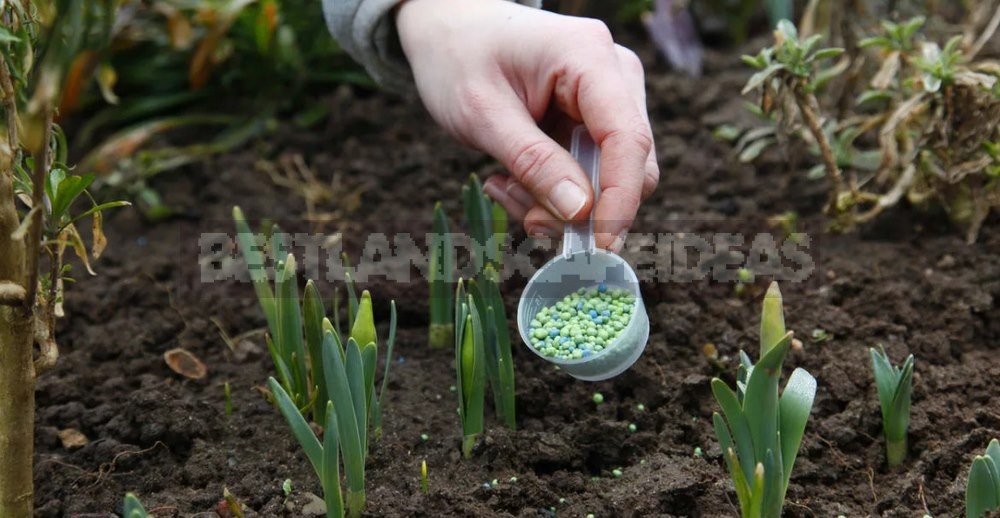
In order for daffodils to delight with abundant flowering from year to year, it is enough not to forget about a single top dressing in early spring. As soon as the snow comes down for the plant, it is better to make a full portion of complex mineral fertilizers (50-60 g (1.8-2.1 oz) per bucket of water (15L – 4 Gal). With normal soil improvement and fertilization before planting (in the spring), fertilizing begins only from the second, and on very fertile soils from the third year after planting. To obtain a more abundant flowering, you can divide the top dressing into nitrogen in early spring and potassium-phosphorus at the budding stage, or conduct two identical top dressing with a halved concentration of full mineral fertilizers.
If daffodils are grown for cutting or want to achieve a more spectacular flowering, you can use another strategy – potassium-nitrogen nutrition.
With this strategy make not one but more than four top dressing:
- When seedlings appear — with a full mineral fertilizer
- When growing flower stalks — nitrogen and potash fertilizers
- During budding — full mineral fertilizer
- During flowering — with phosphorus-potassium fertilizers.
In all four feedings, 20-30 g (0.7-1 oz) of fertilizers are used per bucket of water (15L – 4 Gal) and per square meter (3.2 ft2) of plantings.
With organic fertilizers for this bulbous plant, you need to be very careful. Daffodils do not tolerate manure and it should not be used either in the pre-planting improvement of the soil, or in further care.
Growing at Home
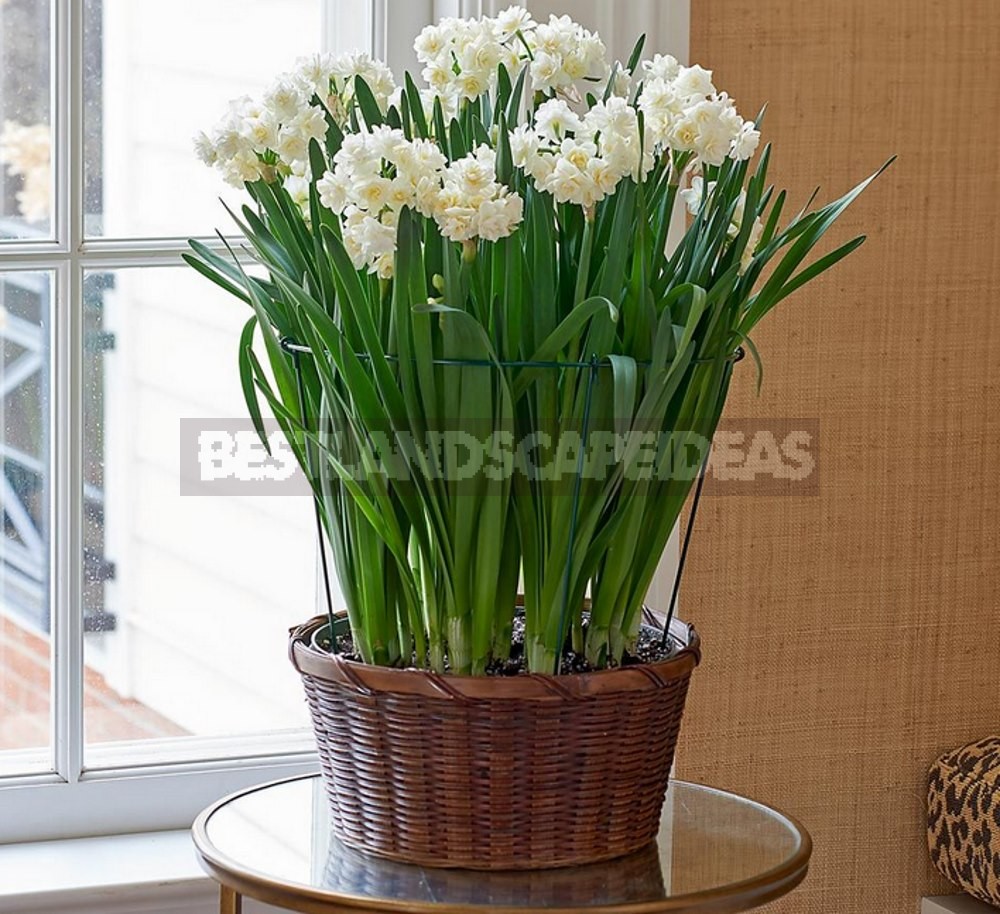
Many people are used to seeing blooming daffodils in flower beds, believing that this is only a garden flower. However, it is quite possible to grow daffodils at home, the benefit of doing this is not particularly difficult.
Deadlines
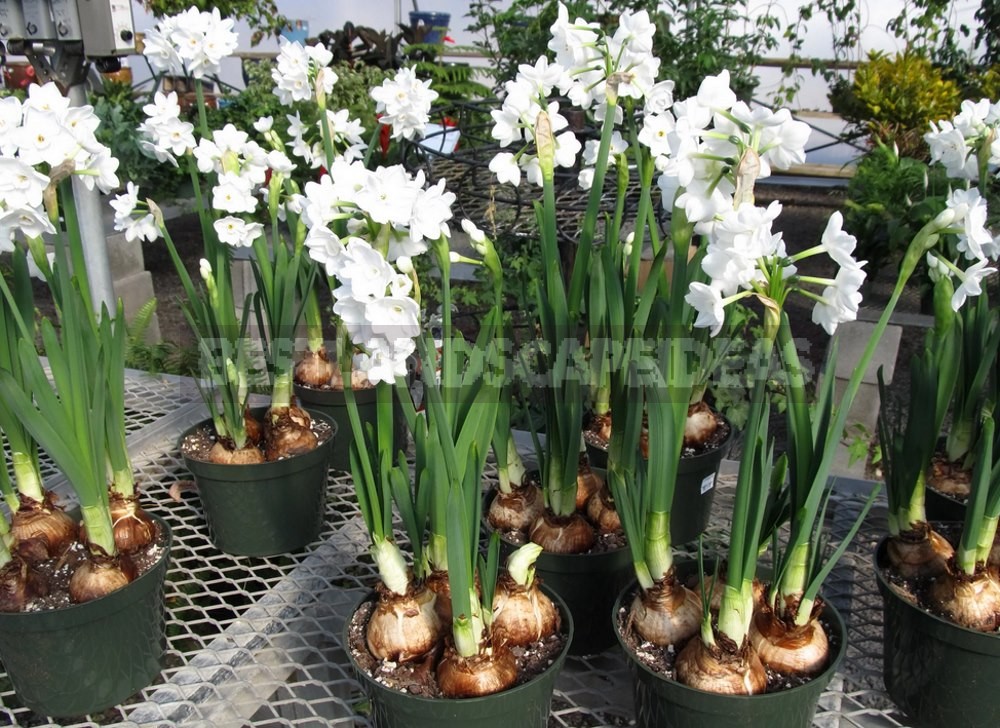
- Early planting – for the New Year holidays
- Average planting – for the holiday of March 8 (from February 1 to March 8)
- Late planting – from April 1 to May 1.
For early planting, it is necessary to choose healthy and large bulbs with a diameter of at least 4-5 centimeters (1.6-2 inch). Before planting, which is carried out in August, the bulbs are subjected to temperature treatment according to the following scheme: 4 days at 35°C (95°F), 14 days at 30°C (86°F) and 7-14 days – at 15°C (59°F).
For medium and late planting, smaller bulbs will be required, and there is no need to expose them to high temperatures. Before planting, they are stored in a fairly cool place (no more than 10-15°C (50-59°F).
For medium-sized planting bulbs are planted in the prepared substrate in September, and for late-in October.
Rules for Planting Bulbs
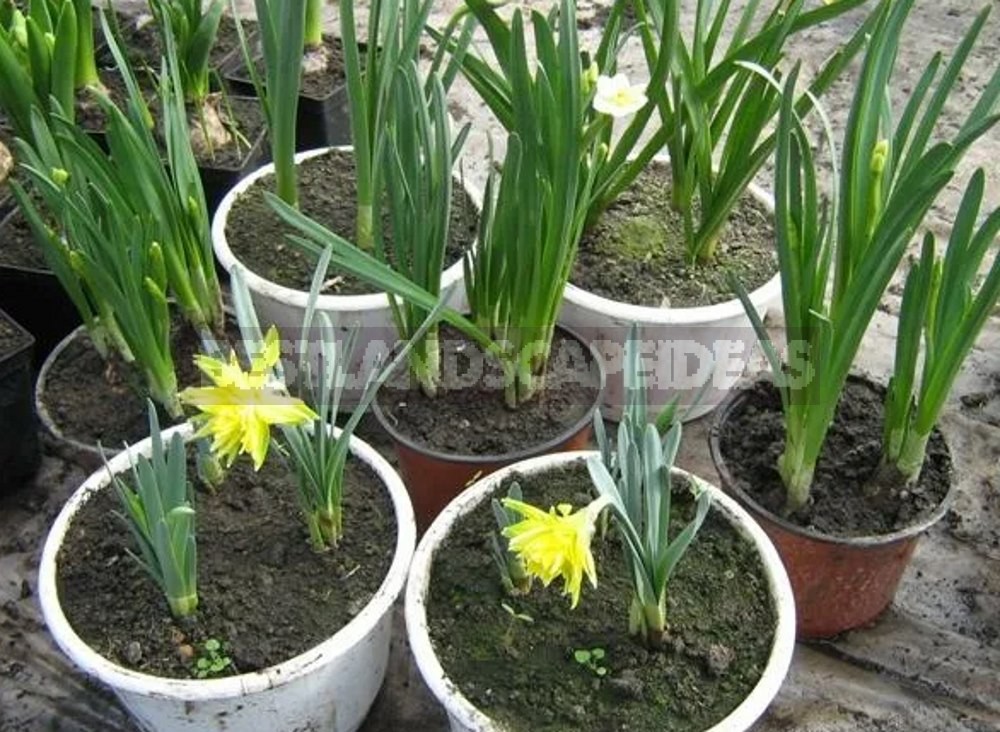
In the allotted time, choose a moisture-and air-permeable soil consisting of a mixture of peat and pure sand. In a pot with a diameter of 15 centimeters (6 inch), you can plant about 5 to 6 bulbs.
Before planting the bulbs, it is necessary to lay out a layer of drainage on the bottom, and the substrate is slightly compacted and moistened. On top of the soil mixture is sprinkled in such a way that the tops of the bulbs are half raised above the soil level.
Temperature Regime and Top Dressing

For the first 3 to 4 months, the pot of bulbs should be kept in the lower part of the refrigerator, at a temperature of 5 to 8°C (41-46.4°F). At the same time, it is not necessary to wrap it with polyethylene, since this contributes to the accumulation of excessive moisture and pathogenic bacteria, and the natural air circulation is hindered.
With the appearance of the first sprouts, reaching a height of 5-6 centimeters (2-2.4 inch), the pot can be removed from the refrigerator and placed in a cool (about 10°C (50°F) heat) and bright room, and begin moderate watering (once every two weeks, as the soil dries completely).
Like all bulbous plants that are planted in winter, daffodils at home need additional lighting. Ideally, use daylight lamps that are attached directly to the window frame.
After a week, the pots with sprouts should be moved to a warmer room and start feeding. It is best to use special fertilizers with a pH = 8-10, intended for bulbous (tulips, lilies, hyacinths, gladioli, etc.). Fertilizers are applied with every second watering, until the buds appear. During the flowering period, fertilizing should be stopped.
Pest and Disease Control

Despite its status as a crop that grows almost without interference, daffodils are quite often affected by pests and diseases. They often have root mites, nematodes, and onion babblers. At the first signs of damage, insecticides should be used and in the future, every spring, before the appearance of buds, preventive treatments should be carried out.
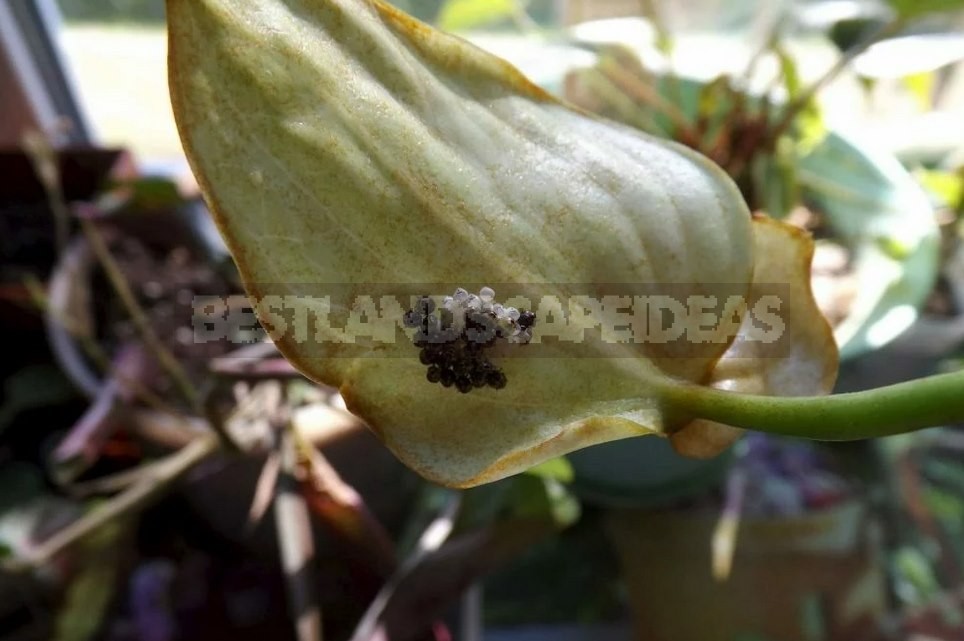
Due to diseases, daffodils suffer from various types of rot, fusariosis and sclerotiniosis. They fight these diseases with copper-containing fungicides (for example, copper sulfate diluted with water at a concentration of 100 g per 1 bucket (15L) – 3.5 oz per 4 Gal).
Variety of Shades
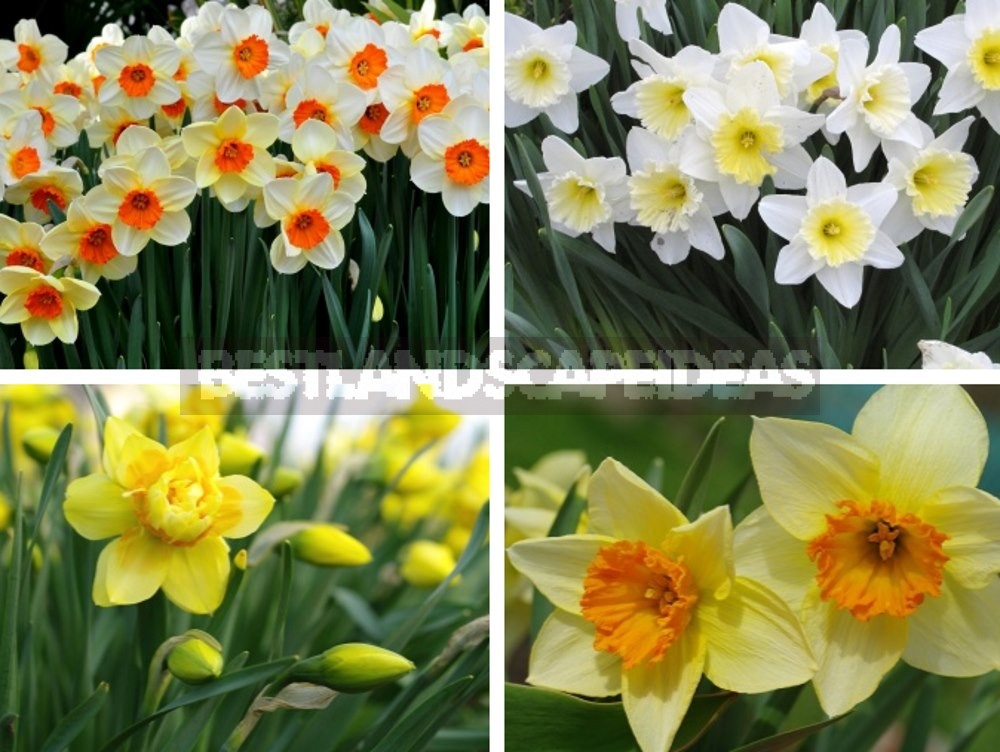
The flower is a member of the Amaryllis family of the genus of monocotyledonous bulbous plants. The daffodil bush has many ribbon-shaped leaves, the width of which may differ slightly in different species. A long stem without leaves (pedicel) can carry one or more inflorescences located on its top.
In addition to wild species, there are many cultivated, bred varieties. First of all, daffodils differ in the color of their inflorescences.
White Daffodils
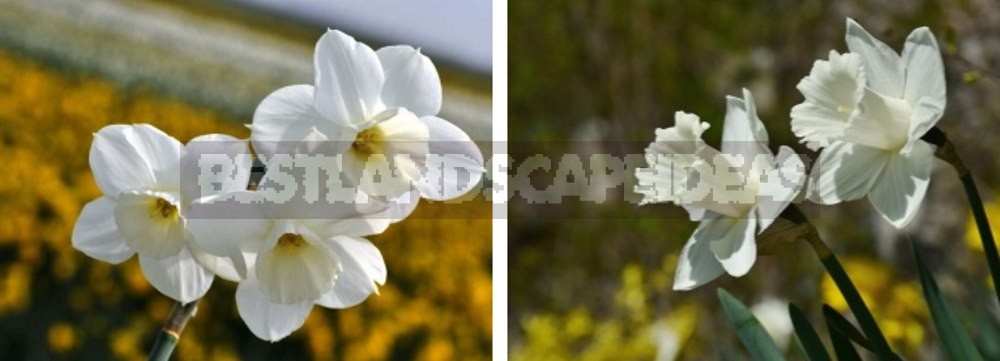
The birthplace of this plant is the Iberian Peninsula, where the flower grows on mountain slopes. Cultural breeding of this species began at the end of the XVI century. The white narcissus inflorescences are completely pure white, including the inner crown. The height of the bush can reach 35 cm (14 inch), and the length of the pedicel is about 25 cm (10 inch). The plant has thin numerous leaves of a rich green color. The plant reproduces, like all daffodils, with globular bulbs that are small in size (about 4 cm – 1.6 inch). Active growth occurs in mid-spring, and flowering occurs in late May and does not last long – only 10 days.
Yellow Daffodil
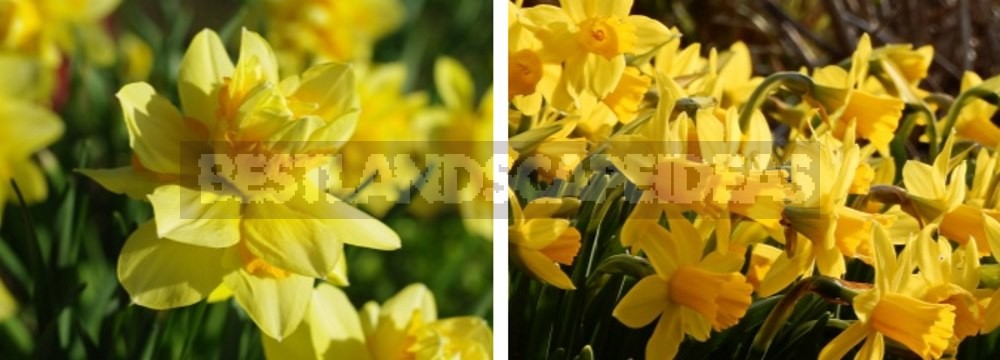
In the wild, it grows in European countries-France, Germany and southern Italy. The culture is quite old: it has been cultivated in garden floriculture since the beginning of the XVI century. This species is distinguished by its small size — the maximum height is 30 cm (12 inch). The pedicel has only one inflorescence, the size of which is about 4 cm (1.6 inch). The flowers rise above the thin leaves of a dark green color by about 10 cm (4 inch). The fully opened inflorescence has a bright yellow crown with uneven wavy edges. Yellow daffodil begins to bloom in mid-May, the duration of flowering is about 2 weeks. Bulbs of small size (up to 4 cm – 1.6 icnh) have a round shape in the form of a ball.
Pink Daffodils
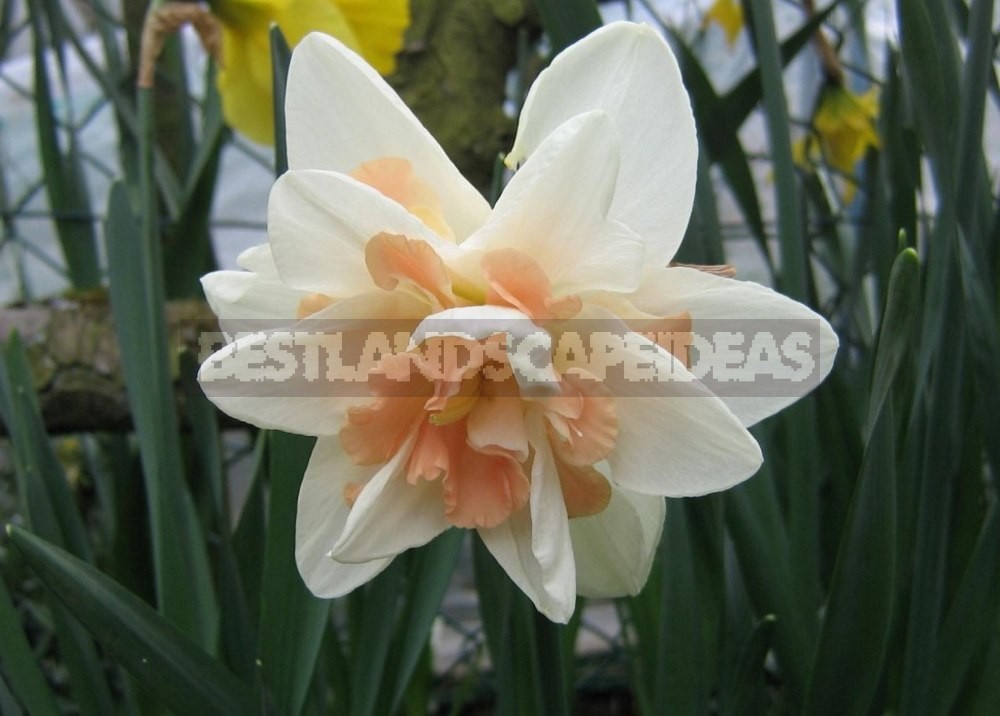
This species is widely distributed in the western regions of Italy, from where it was introduced to France in the XVI century. The plant is tall, can grow up to 45 cm (18 inch) or more, which is its characteristic difference from other species. The leaves of the rich green color are also slightly wider (about half a centimeter) than those of other daffodils. The color of the inflorescence has an uncharacteristic feature for daffodils: the crown is painted in a delicate pink color and is framed by snow-white petals of the perianth. The pedicel has only one bud, which blooms in the first days of May. The size of the bulbs is quite large – about 5 cm (2 inch).
Types of Daffodils
The inflorescence of the narcissus has the form of a tubular funnel (bell), whole or consisting of separate fragments, the base of which is bordered by a perianth in the form of spread petals. Depending on the shape of the flower and its color, plant species are divided into the following groups (classes).
Tubular Daffodils
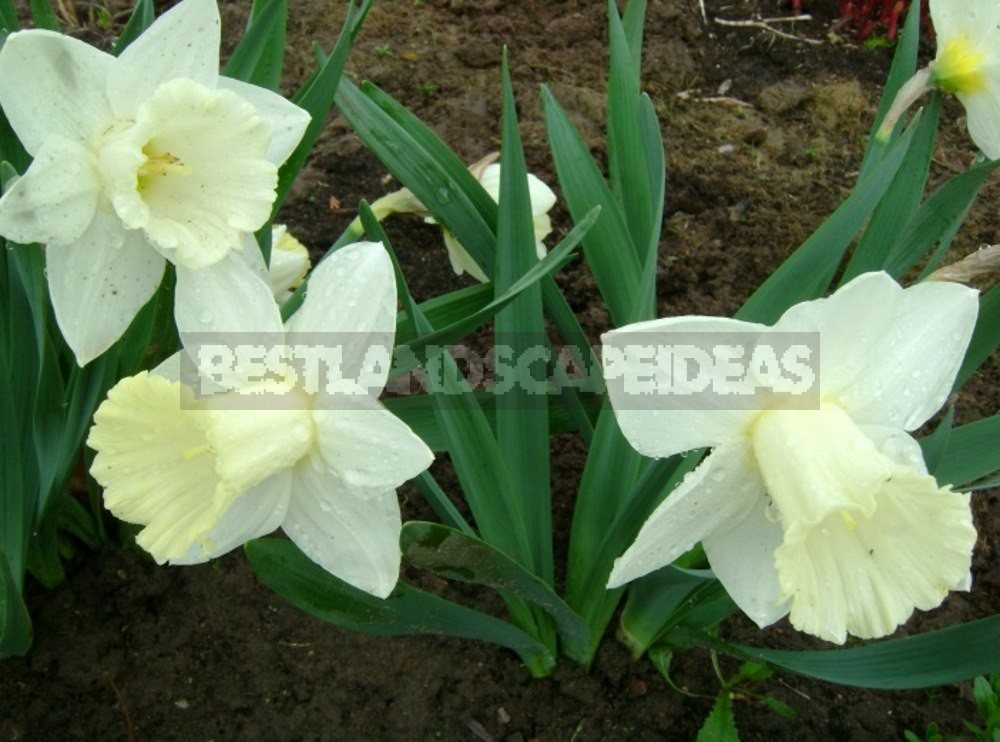
This group is characterized by the presence of only one bud on the stem, the length of which can be from 15 to 45 cm (6-18 inch). The crown, which has the appearance of a long tube, corresponds to or slightly exceeds the length of the perianth. Inflorescences can be colored monotonously in white, yellow, or have a two-color color: the peduncle and perianth are colored differently. Daffodils of this group are distinguished by early flowering.
Large Cupped Daffodils

A characteristic feature of this group is that the length of the crown is 3 times less than the size of the petals of the perianth. The crown can be wavy or smooth. These daffodils are distinguished by a two-tone color of the inflorescences, which has a wide variety of color combinations: the lower petals of the perianth are white, cream, yellow, and the crown is white or cream, yellow, orange, or pink with a brighter border along the edge, which can be corrugated and slightly bent.
Small Cupped Daffodils
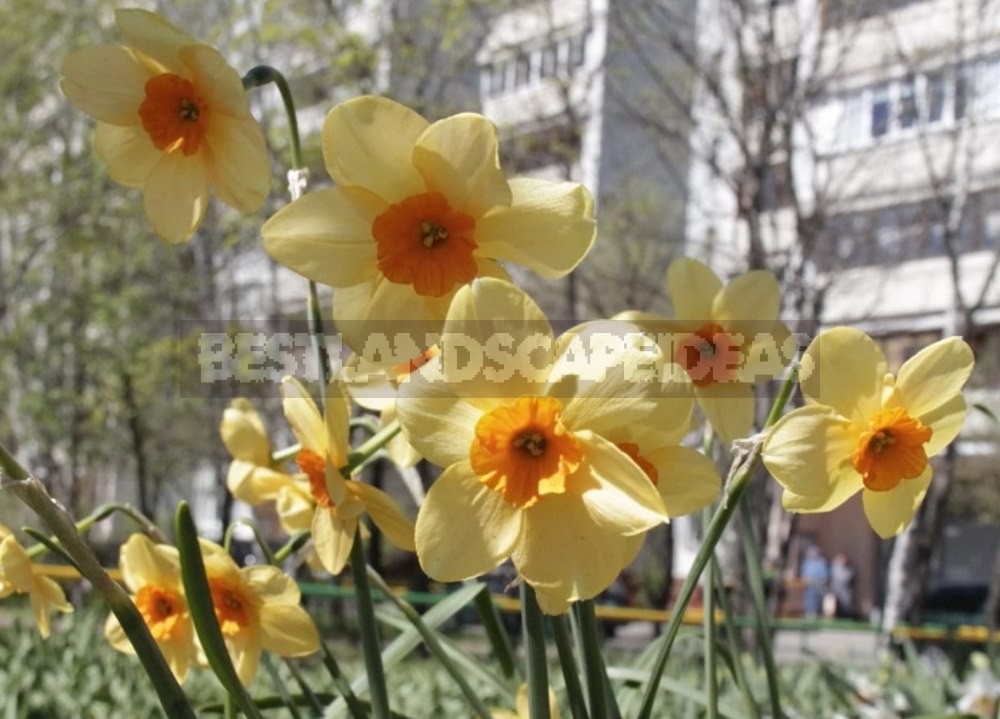
The name of this group reflects a characteristic feature of plants: the size of the bell is small and does not reach even a third of the length of the perianth. The peduncle has a single bud. The lower petals are white, yellow, and cream in color. The crown color is most often peach, yellow or orange, pink and even with a red tint. Often, a border of a more saturated tone runs along the edge. Flowering is later, but they bloom profusely.
Terry Daffodils

This type is completely different from the classic plant species. The stem can bear not one, but several buds. Terry can be both a perianth, and a crown, and even a combination of these two options. The flowers are monotonously colored (white, yellow) and bicolored (white with a reddish crown). The pedicel often can not stand terry caps, especially heavy after the rain, and breaks off. This is considered a disadvantage of this type.
N. Triandrus L Daffodils
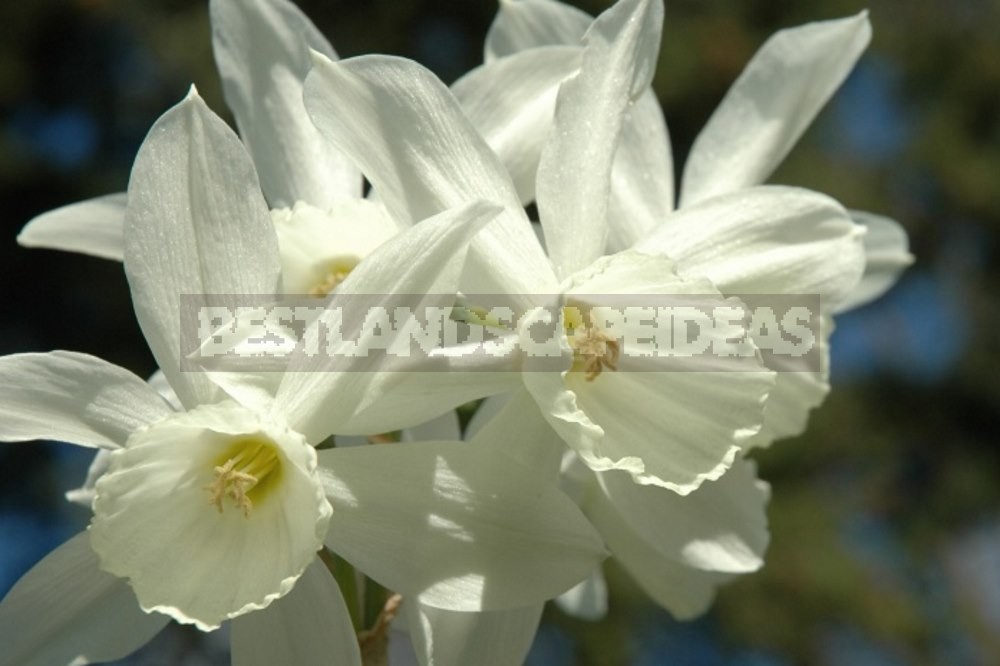
The plants are distinguished by a low peduncle (about 25 cm – 10 inch), bearing 2 or more inflorescences, which are slightly lowered. The lower petals at the base of the crown are slightly bent back. The flowers are most often colored in white, yellow, and golden tones.
Cyclamineus Daffodils
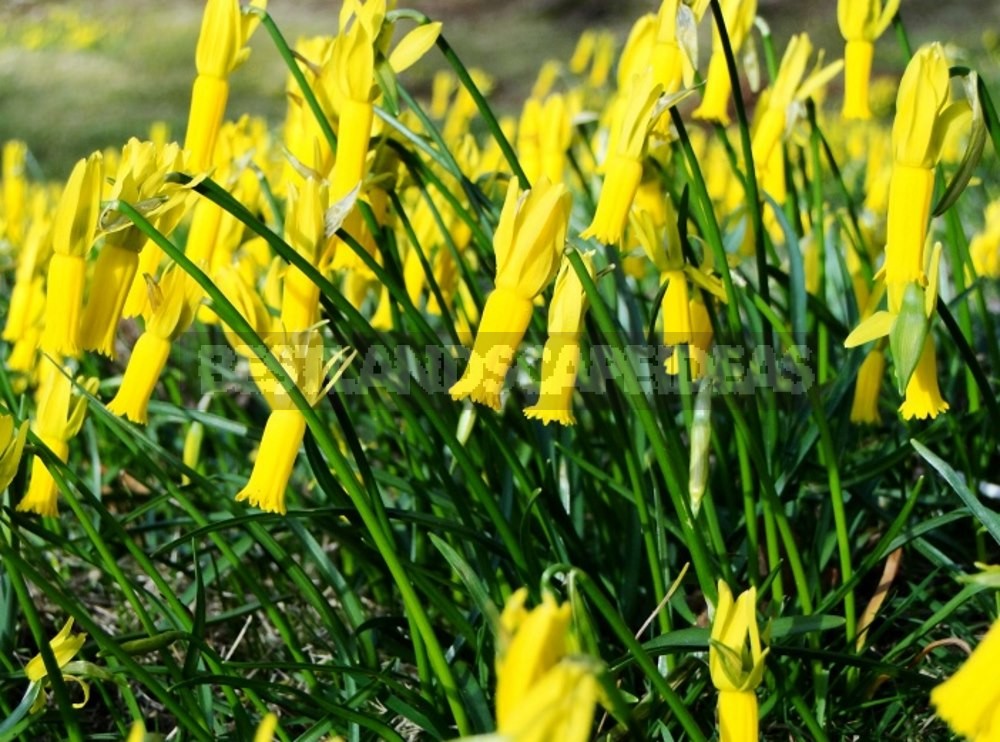
The name itself speaks of its unusual appearance — on a short (15-25 cm – 6-10 inch) pedicel there is one inflorescence, with a long and narrow crown, lowered down. The petals of the perianth at its base are strongly bent back. They can have both one and two-color coloring. The main shades are white, yellow, and orange.
N. Jonquilla L. Daffodils

The relatively short pedicel has from 2 to 6 small flowers. These daffodils are distinguished by the rounded shape of the lower petals, which are slightly bent back. The crown also has a somewhat peculiar appearance — a small and short, but wide bowl. Inflorescences are usually yellow or white.
Tazetta Daffodils
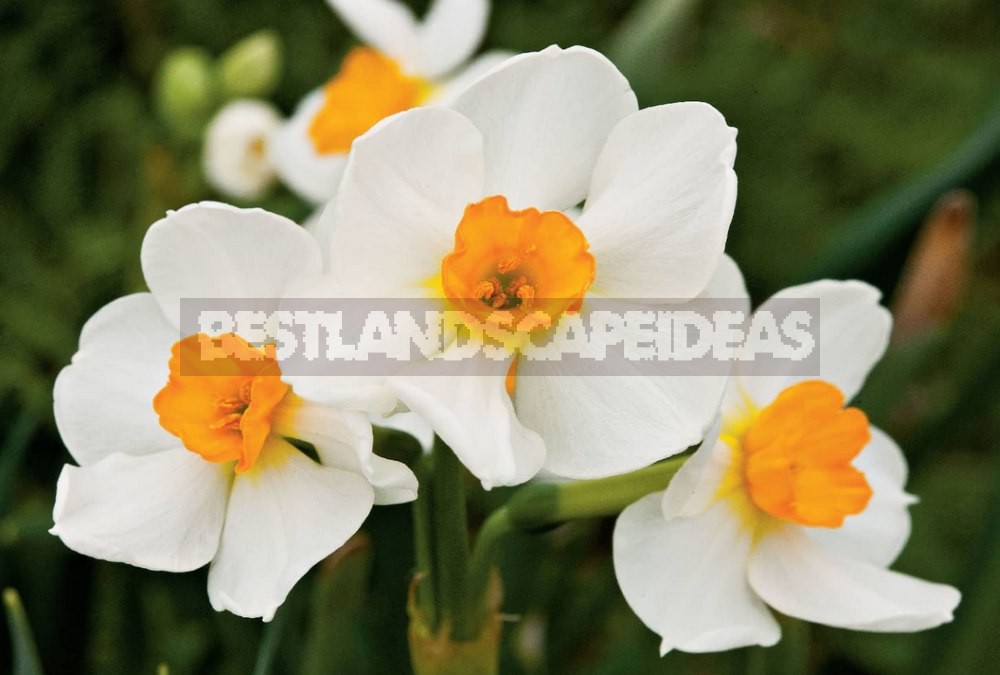
In representatives of this species, the peduncle is from 15 to 45 cm (6-18 inch) long and has several buds (from 2 to 8). The prostrate petals with a wavy surface have a rounded shape, and the short crown has the shape of a glass. The leaves of the bush are wide, dark green in color. The flowers themselves are painted in white, cream, yellow tones.
Poeticus Daffodils

This group is widely distributed on the Mediterranean coast. The plants are tall, reaching 50 cm (20 inch). One bush can have up to 5 long leaves of a bright green shade. The pedicel is higher than the leaves. On the peduncle blooms one white flower with an inner bell in the form of a disk, yellow in color. Its middle can be a greenish tone, turning into a bright yellow shade with a reddish rim along the edge. The heads of the inflorescence are directed downwards. The size of the flower in the phase of full disclosure is about 6 cm. Blooms in May for 12 days.
Split-corona: Collar and Split-corona: Papillon

The peculiarity of this group of daffodils is that the crown is not whole, but is divided into separate fragments with a fringed edge. There is only 1 inflorescence on the pedicel. There are two subspecies: split-corona (the petals of the bell are located above the petals of the perianth and are adjacent to them), papillon (the shape of the flower has the appearance of a butterfly). The tube can be very different colors — white, red and pink, yellow and orange.
Hybrid (N. Bulbocodium)
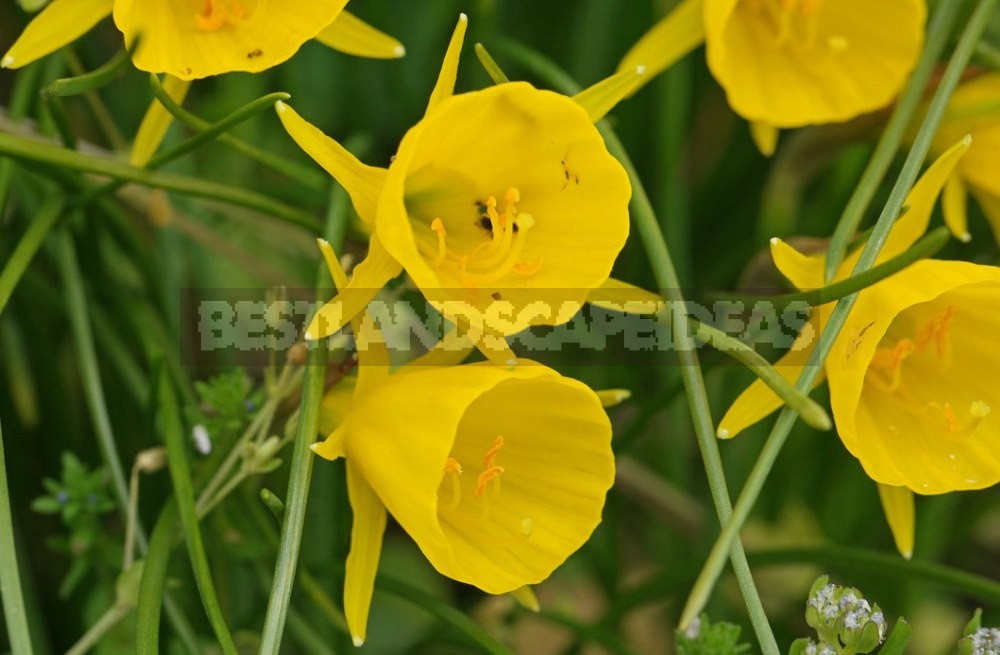
Plants of this class have a low stem (only up to 15 cm – 6 inch) with a single inflorescence. The narrow petals of the perianth are underdeveloped and differ in very small size. The crown in the inflorescence, on the contrary, is large, wide-open and has a peculiar shape of a crinoline skirt.
Best Flower Varieties with Names
There are about 60 species of daffodils in nature. Breeding work with this flower has been carried out since the XVIII century, and as a result, a huge number of varieties have appeared, which is estimated at several thousand. The most popular and beautiful varieties are also very many, among them the following.
Cool Flame

This variety belongs to the group of large-billed daffodils. The inflorescence is bicolored: the crown is painted in a rich orange shade, sometimes turning into coral, stands out brightly against the background of the snow-white lower petals. The crown has a characteristic strongly wavy edge. The height of the bush reaches 40-45 cm (16-18 inch), the size of the flower – 10 cm (4 inch). Flowering occurs in April or May. The plant is characterized by unpretentiousness and grows well both in sunny and shaded places.
Rip van Winkle

A representative of the terry group. The bushes of the plant are low, growing on average up to 30 cm (12 inch), and the broad leaves are slightly lower than the flower on the peduncle. Both the lower petals and the tube are double. Strong terry is created due to the large number of petals that have different growth directions. On the pedicel, only one flower blooms, which is colored in a thick yellow shade. In the open ground, it is grown both in illuminated areas and in the shade.
Bridal Crown
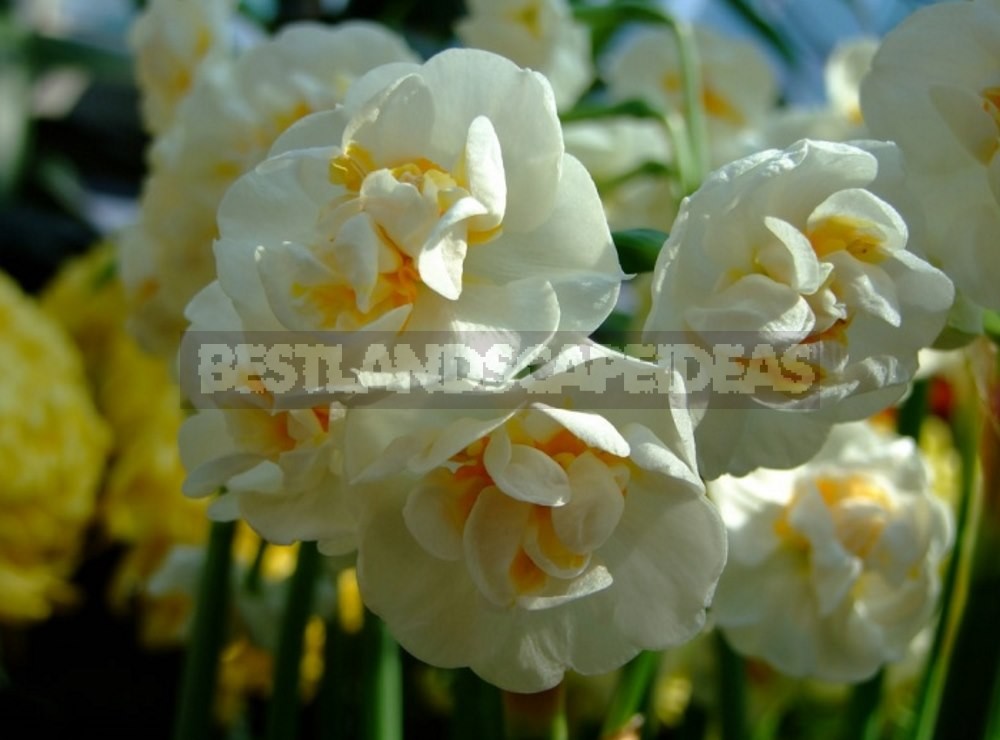
Each petal of the perianth of this variety has the shape of an ellipse and has a snow-white or cream color. On the stem there can be up to 4 buds, which after full opening turn into thick double flowers with soft cream lower petals and a yellow crown in the center. The edge of the tube is corrugated. The height of the plant is from 30 to 45 cm (12-18 inch), the inflorescences are small — up to 4 cm (1.5 inch) in diameter. Flowering occurs in mid-May.
Dick Wilden

Large-flowered terry variety, a feature of which is a very early flowering in March. The height of the bush is about 50 cm (20 inch), and the inflorescences reach a size of 15 cm (6 inch). The wide (up to 8 cm – 3 inch) lower petals are oval in shape and are colored yellow with a greenish tint. In the center of the inflorescence there is a thickly-terry lush bell of a dark yellow tone.
Rosy Cloud

Pink daffodil terry group. Even among other terry towels, it stands out for its beauty and atypical nature. The lower petals of pink-pearl color frame the luxurious crown. The terry crown of a delicate pink color is formed by tightly seated petals, which amaze with their lightness and airiness, justifying their name – “Pink Clouds”. The size of the inflorescence is 5-7 cm (2-3 inch), and its color can change its saturation in accordance with the weather. Blooms profusely for 7-10 days.
Arctic Bells

The variety belongs to the hybrid group Bulbocodium. It is characterized by early and abundant flowering. The height of the bush is up to 20 cm (8 inch). The stem is 25 cm (10 inch) high and bears only one flower, which rises above the leaves. The narrow and small greenish petals of the perianth are bent back. The large bell has a conical (in the form of a crinoline) shape and its size is much larger than the lower petals. The color of the crown is white or ivory. The leaves of the bush are very thin, almost thread-like, rich green in color. One bulb can produce several flower stalks with buds. Blooms in April and May.
Albus Plenus Odoratus
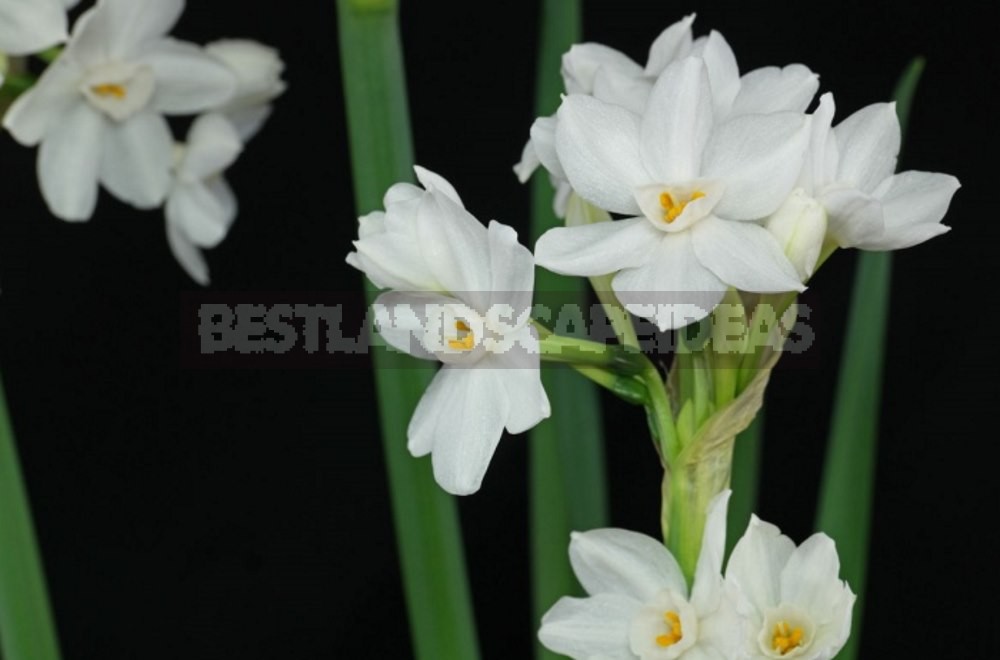
This variety of daffodils is the latest: its flowering occurs in the last decade of May — early June. In its appearance, it bears little resemblance to the classic daffodil: its light, corrugated petals grow in several rows, and there is no clearly defined crown. But even the small and neat middle stands out for its bright yellow color.
Calgary

This is a variety of white terry daffodils. Terry balls of inflorescences are very similar to small peonies. The peduncle grows up to 40 cm (16 inch) and bears 2 buds. The flower is about 10 cm (4 inch) in size and has many petals of a bright white color with a barely noticeable greenish tint. The yellow stamens, located in the very center of the lush ball, seem to glow with a golden light. The shrub has narrow lanceolate leaves of green color with a bluish tinge. Flowering occurs in May for 10 days. It is not capricious in cultivation, but prefers open, illuminated areas.
Delnashaugh

Double-colored terry variety. The plant has extremely beautiful flowers with gently airy petals. On the peduncle there is only 1 inflorescence, but it is quite large (up to 15 cm – 6 inch) with large snow-white rounded petals that border the lush pink-peach center. The petals (white perianth and cream-pink multi-tiered crown), alternating, gently shade each other. Blooms in May for a long time, almost 2 weeks. The rich color is preserved until the end of flowering.
Sunny Girlfriend

Among relatively new varieties, it is already quite popular. The daffodil belongs to the split-horned group. It differs from other varieties of this variety in that its bell is cut to the very base. The well-opened crown with a yellow center is painted in delicate pink-orange tones. Openwork-wavy edges have a more saturated color. The lower petals are white and slightly longer than the crown. The same group includes the narcissus “Electrus”. Its coral-colored crown is fully expanded to a white perianth, and each bell fragment lies on the lower petals.
Cum Laude

A variety of pink daffodils. The plant reaches a height of 45 cm (18 inch). The extraordinary beauty of the inflorescence is created by a spectacular combination of a pink crown with white petals at its base, which seem to intertwine with each other. The light yellow color of the middle of the tube gradually turns into a creamy pink, which becomes more saturated at the edge. The variety is characterized by high resistance to frost.
Pride of Lions
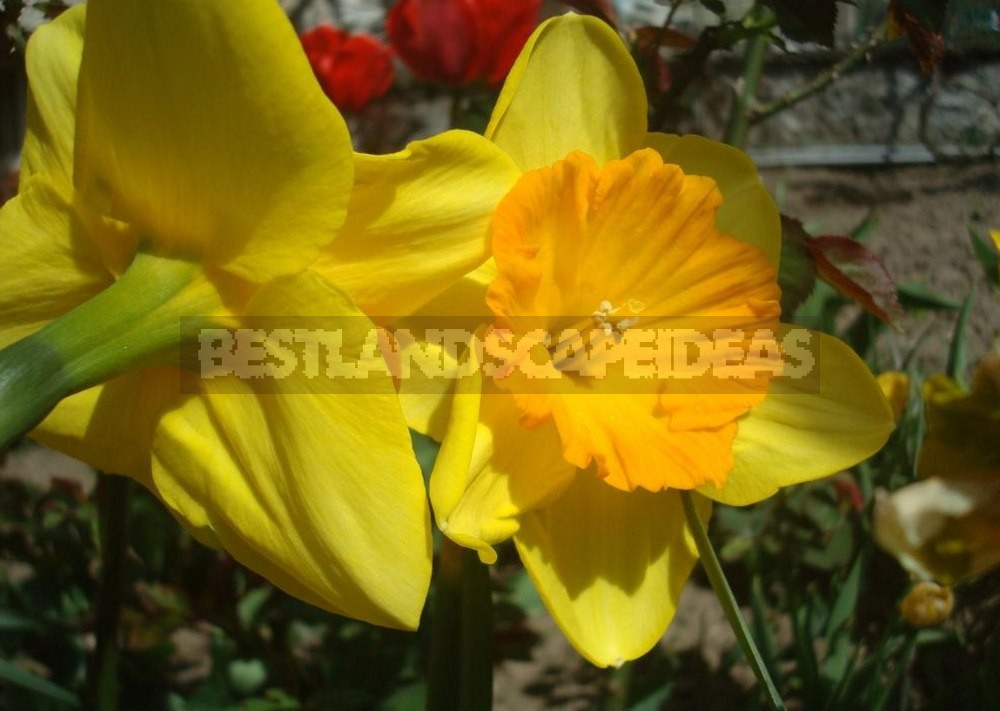
Large-crowned daffodil with a bush height of about 45 cm (18 inch) and a flower of about 10-12 cm (4-5 inch). The large inflorescence has lemon-yellow lower petals and a bright orange crown with a red rim at the base. It is well opened and has the appearance of a cup. The openwork edges of the bell are evenly corrugated. It should be noted that all varieties of daffodils have a delicate delicate aroma.
Tips for Choosing
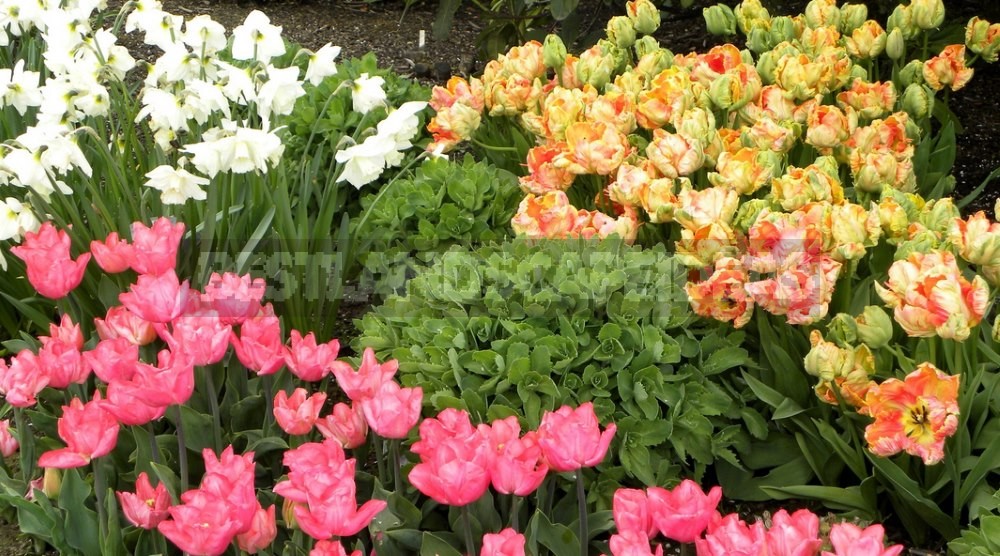
Daffodil is considered one of the most unpretentious flowers, which easily adapts to any conditions. When there is a huge variety of species and varieties, it is often difficult to decide when choosing. It must be remembered that the plant does not bloom for long. You can extend this process if you plant daffodils with different flowering periods, and then they will decorate the flower garden from March to May. Especially impressive are the simultaneously blooming daffodils of several varieties of different colors and shapes. Professionals advise novice gardeners to grow one proven variety first before gaining experience.
When choosing, you should also take into account the combination of narcissus with other flowers growing in the flower bed. They can be planted, and they will look great next to hyacinths, crocuses, but their proximity to tulips is especially impressive. If there are low flowers in the flower garden, such as viola, you can safely choose different varieties, in this case they will be harmoniously combined.
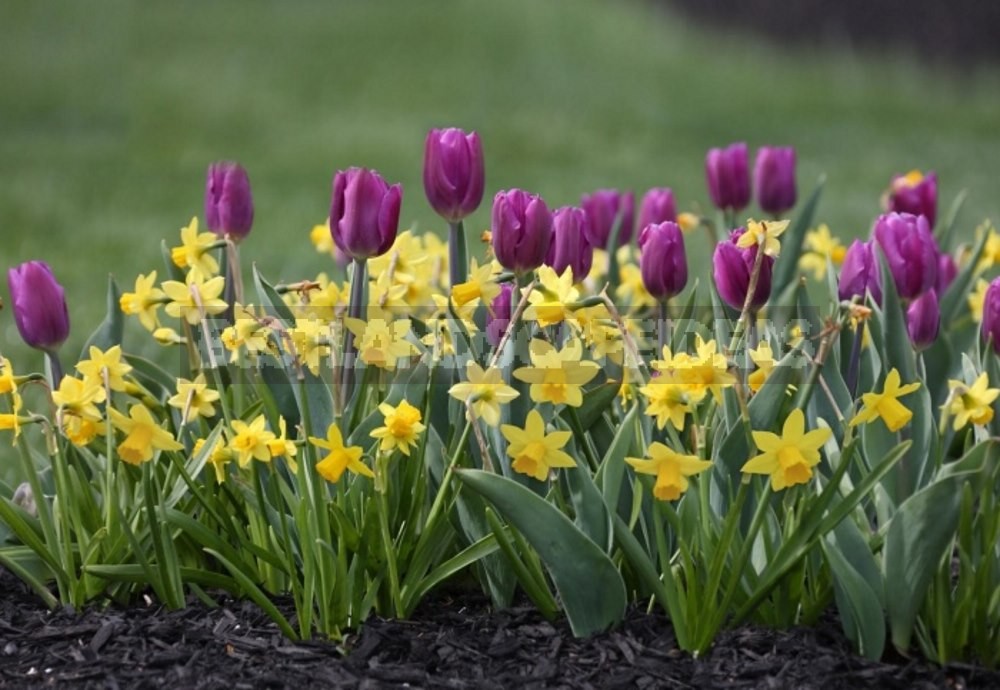
For the design of flower beds with tulips and mixed lawns, choose varieties of yellow options, and for garden alpine slides cyclamineus-like daffodils are best suited. Pink options views will look original in any composition. Large Cupped varieties decorate the borders. Terry varieties can even be grown at home. Daffodil can be considered a universal flower, since all its varieties and types are perfect for decorating lawns, flower beds and other elements of the garden, back and front yards.
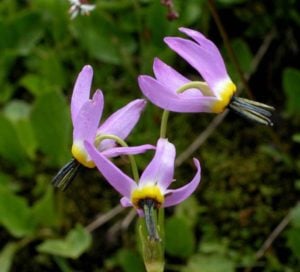
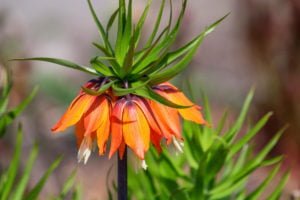
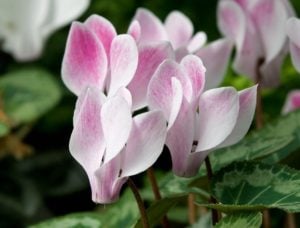
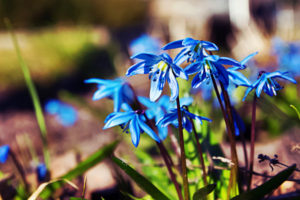
Leave a Reply